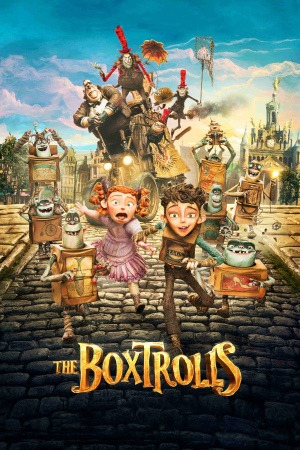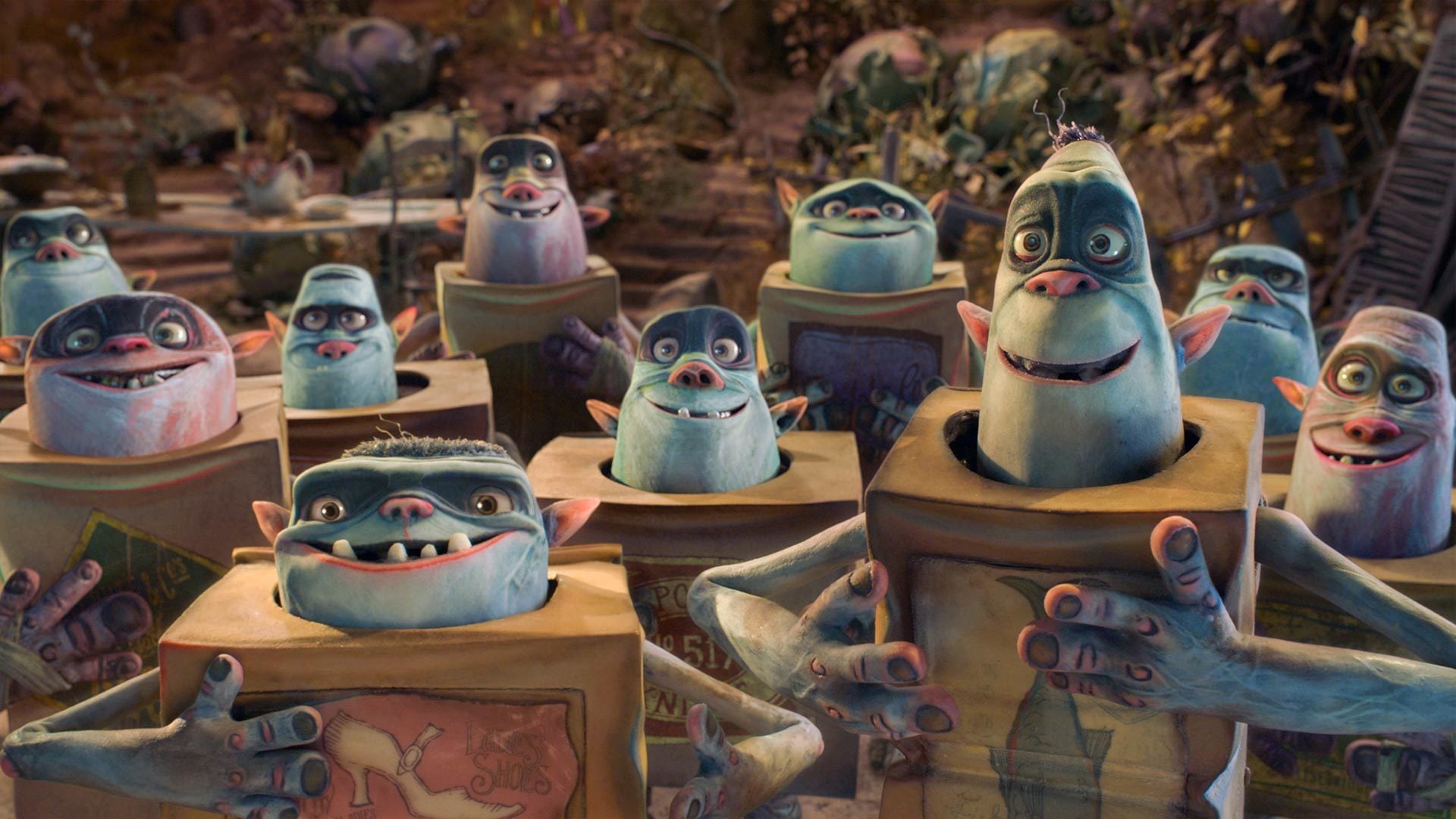
Cardboard characters
Three films in, I think it's safe to say that Laika has hit the point where it can do anything it wants. The studio, founded by the CEO of Nike essentially so that his son Travis Knight could finance Coraline for director Henry Selick in 2009, had already proven with its second film, 2012's ParaNorman, that it had a distinctive personality and aesthetic system that was independent of any one directorial stamp, and started to give us all cause to hope that maybe oh maybe, we were looking at the forming of a replacement for the newly dethroned Pixar. And now, with The Boxtrolls, we find that on top of everything else, Laika has perfected its art: the new film is an iterative technological improvement over ParaNorman, but mostly in small fussy ways that the viewer hardly notices. Instead of representing a great leap forward, then, it's simply a demonstration of what wonderful things the studio artists are capable of: if it improves upon ParaNorman, it's because The Boxtrolls is so utterly fearless in loosing its ambitions, doing anything and everything and doing it just about perfectly. It has its limitations - a charming and honest script that's a bit too reflexively derivative of, like, every other animated family film of the 2010s, mainly - but the eye-popping complexity and coherence of the world created by the sublimely nuanced animation and design is absolutely not one of them.
Adapted by Irena Brignull and Adam Pava with very little fidelity from Alan Snow's book Here Be Monsters!, the film takes place in a town that can't be precisely fixed to late 19th Century England, but there's no good reason not to assume that's it. Here in Cheesebridge, precariously built right up the slope of an unrelentingly steep mountain, the people live in fear of creatures called boxtrolls, which come out at night to still anything not strapped down, including, apparently, a baby. The theft of this baby, and the presumptive cannibalism that follows, puts the people of Cheesebridge into visceral terror, which abates only a little when Lord Portley-Rind (Jared Harris) reluctantly appoints Archibald Snatcher (Ben Kingsley), the town exterminator, to the task of ruthlessly slaughtering every boxtroll he can find. In exchange, when the task is complete, Snatcher will be granted a rare, precious White Hat, which shall allow him entry into Cheesebridge's top echelon of power brokers and enthusiastic cheese-eaters.
Thing is, the boxtrolls didn't eat the boy, who ten years later has grown up to think himself one of the boxtrolls, Eggs (Isaac Hempstead Wright) - boxtroll culture involves taking your name from the word most prominent on the cardboard box you take to be your lifelong home and sole article of clothing. This inconvenient reality hasn't prevented Snatcher from disappearing most of the boxtrolls in the intervening decade, a horrible reality that Eggs alone seems to notice, and he's finally put in a position to do something about it when he is spotted during one night's junk raid by Winnie (Elle Fanning), the daughter of Lord Portley-Rind himself. She tracks him down, pulls him back into human society, and he starts to uncover Long-Hidden Secrets, as will happen.
The story is confidently and clearly expressed, though that does not change the fact that it's a bit on the trite side in some ways, and it's far more predictable than Coraline or ParaNorman ever even thought about being. Still and all, the point here is so obviously not to be dazzled by the story, but by the world the story inhabits, and the characters fleshing it out. The Boxtrolls is an absurdly beautiful movie, like a Tim Burton dollhouse only with infinitely brighter colors. Its fussy, tactile world of weathered storefronts and damp streets and a clear distinction between the places that are decayed and dying versus the places that are merely old and comfortable certainly makes it one of the most self-contained works of production design I have seen in 2014, so thanks be to designer Paul Lasaine for that. But just as crucial is the character animation, done in Laika's complex but hugely rewarding technique of animation on a computer, printing each face on a 3-D printer, and then applying those faces to puppets being carefully photographed in computer-aided stop-motion. The cast of The Boxtrolls are almost uniformly grotesque (even the heroes, in their tiny way: Eggs has snarled teeth, Winnie has a rather unhealthy-looking pale complexion with ruddy cheeks), but in a way that adds to the storybook charm of the whole, and the distorted, caricatured faces are well-suited to the subtle manipulations that make them feel like nuanced pieces of acting. And that being said, the voice acting is great as well: with this film, Laika achieves a Pixar-level triumph in casting a surprisingly deep bench of famous people (Nick Frost, Simon Pegg, Tracy Morgan, Richard Ayoade, and Toni Collette are also involved), but clearly because they fit the part, not because e.g. Ben Kingsley is such a slam-dunk marquee name for an animated comedy - in fact, Kingsley gives one of the most unrecognisable performances in the film.
It is, all told, a simple fable in comparison to Coraline's more thorny deconstruction of fabulous elements, and ParaNorman's wildly unconventional approach to dramatising childhood trauma and psychology. But simplicity isn't a sin, and the film's messages - don't lie to yourself, be nice to people who aren't like you - are certainly useful and valuable even if they're a bit obvious. Besides, it's a tremendously fun movie: filled with weird British-style jokes, from the odd puns ("Something unspeakable has happened! We must speak of it!" is almost the film's first line, and it's far from being the most enchantingly silly bit of wordplay), to the almost Wallace-like obsession with cheese-based humor. It's witty in a way that's easy to grasp for children while also failing to be in any way insulting to adults, which is an impressively hard target to hit; it also gives the film a certainy zaniness that keeps it from turning either sluggish or dark in its protracted, smoke-filled finale, and helps to make the bent design of the movie feel lovingly idiosyncratic and not just warped for warped's sake. It's all a little precious and delicate, but so beguiling that what could feel airless is instead charming, funny, and full of life. I'm not prepared to declare the Age of Laika just yet, but if they keep it up for just one more film...
Adapted by Irena Brignull and Adam Pava with very little fidelity from Alan Snow's book Here Be Monsters!, the film takes place in a town that can't be precisely fixed to late 19th Century England, but there's no good reason not to assume that's it. Here in Cheesebridge, precariously built right up the slope of an unrelentingly steep mountain, the people live in fear of creatures called boxtrolls, which come out at night to still anything not strapped down, including, apparently, a baby. The theft of this baby, and the presumptive cannibalism that follows, puts the people of Cheesebridge into visceral terror, which abates only a little when Lord Portley-Rind (Jared Harris) reluctantly appoints Archibald Snatcher (Ben Kingsley), the town exterminator, to the task of ruthlessly slaughtering every boxtroll he can find. In exchange, when the task is complete, Snatcher will be granted a rare, precious White Hat, which shall allow him entry into Cheesebridge's top echelon of power brokers and enthusiastic cheese-eaters.
Thing is, the boxtrolls didn't eat the boy, who ten years later has grown up to think himself one of the boxtrolls, Eggs (Isaac Hempstead Wright) - boxtroll culture involves taking your name from the word most prominent on the cardboard box you take to be your lifelong home and sole article of clothing. This inconvenient reality hasn't prevented Snatcher from disappearing most of the boxtrolls in the intervening decade, a horrible reality that Eggs alone seems to notice, and he's finally put in a position to do something about it when he is spotted during one night's junk raid by Winnie (Elle Fanning), the daughter of Lord Portley-Rind himself. She tracks him down, pulls him back into human society, and he starts to uncover Long-Hidden Secrets, as will happen.
The story is confidently and clearly expressed, though that does not change the fact that it's a bit on the trite side in some ways, and it's far more predictable than Coraline or ParaNorman ever even thought about being. Still and all, the point here is so obviously not to be dazzled by the story, but by the world the story inhabits, and the characters fleshing it out. The Boxtrolls is an absurdly beautiful movie, like a Tim Burton dollhouse only with infinitely brighter colors. Its fussy, tactile world of weathered storefronts and damp streets and a clear distinction between the places that are decayed and dying versus the places that are merely old and comfortable certainly makes it one of the most self-contained works of production design I have seen in 2014, so thanks be to designer Paul Lasaine for that. But just as crucial is the character animation, done in Laika's complex but hugely rewarding technique of animation on a computer, printing each face on a 3-D printer, and then applying those faces to puppets being carefully photographed in computer-aided stop-motion. The cast of The Boxtrolls are almost uniformly grotesque (even the heroes, in their tiny way: Eggs has snarled teeth, Winnie has a rather unhealthy-looking pale complexion with ruddy cheeks), but in a way that adds to the storybook charm of the whole, and the distorted, caricatured faces are well-suited to the subtle manipulations that make them feel like nuanced pieces of acting. And that being said, the voice acting is great as well: with this film, Laika achieves a Pixar-level triumph in casting a surprisingly deep bench of famous people (Nick Frost, Simon Pegg, Tracy Morgan, Richard Ayoade, and Toni Collette are also involved), but clearly because they fit the part, not because e.g. Ben Kingsley is such a slam-dunk marquee name for an animated comedy - in fact, Kingsley gives one of the most unrecognisable performances in the film.
It is, all told, a simple fable in comparison to Coraline's more thorny deconstruction of fabulous elements, and ParaNorman's wildly unconventional approach to dramatising childhood trauma and psychology. But simplicity isn't a sin, and the film's messages - don't lie to yourself, be nice to people who aren't like you - are certainly useful and valuable even if they're a bit obvious. Besides, it's a tremendously fun movie: filled with weird British-style jokes, from the odd puns ("Something unspeakable has happened! We must speak of it!" is almost the film's first line, and it's far from being the most enchantingly silly bit of wordplay), to the almost Wallace-like obsession with cheese-based humor. It's witty in a way that's easy to grasp for children while also failing to be in any way insulting to adults, which is an impressively hard target to hit; it also gives the film a certainy zaniness that keeps it from turning either sluggish or dark in its protracted, smoke-filled finale, and helps to make the bent design of the movie feel lovingly idiosyncratic and not just warped for warped's sake. It's all a little precious and delicate, but so beguiling that what could feel airless is instead charming, funny, and full of life. I'm not prepared to declare the Age of Laika just yet, but if they keep it up for just one more film...






